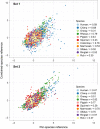Conservation of physiological dysregulation signatures of aging across primates
- PMID: 30746836
- PMCID: PMC6413749
- DOI: 10.1111/acel.12925
Conservation of physiological dysregulation signatures of aging across primates
Abstract
Two major goals in the current biology of aging are to identify general mechanisms underlying the aging process and to explain species differences in aging. Recent research in humans suggests that one important driver of aging is dysregulation, the progressive loss of homeostasis in complex biological networks. Yet, there is a lack of comparative data for this hypothesis, and we do not know whether dysregulation is widely associated with aging or how well signals of homeostasis are conserved. To address this knowledge gap, we use unusually detailed longitudinal biomarker data from 10 species of nonhuman primates housed in research centers and data from two human populations to test the hypotheses that (a) greater dysregulation is associated with aging across primates and (b) physiological states characterizing homeostasis are conserved across primates to degrees associated with phylogenetic proximity. To evaluate dysregulation, we employed a multivariate distance measure, calculated from sets of biomarkers, that is associated with aging and mortality in human populations. Dysregulation scores positively correlated with age and risk of mortality in most nonhuman primates studied, and signals of homeostatic state were significantly conserved across species, declining with phylogenetic distance. Our study provides the first broad demonstration of physiological dysregulation associated with aging and mortality risk in multiple nonhuman primates. Our results also imply that emergent signals of homeostasis are evolutionarily conserved, although with notable variation among species, and suggest promising directions for future comparative studies on dysregulation and the aging process.
Keywords: Mahalanobis distance; aging; biomarkers; dysregulation; homeostasis; nonhuman primates.
© 2019 The Authors. Aging Cell published by the Anatomical Society and John Wiley & Sons Ltd.
Conflict of interest statement
None declared.
Figures



References
-
- Arbeev, K. G. , Cohen, A. A. , Arbeeva, L. S. , Milot, E. , Stallard, E. , Kulminski, A. M. , … Yashin, A. I. (2016). Optimal versus realized trajectories of physiological dysregulation in aging and their relation to sex‐specific mortality risk. Frontiers in Public Health, 4, 3 10.3389/fpubh.2016.00003 - DOI - PMC - PubMed
-
- Bates, D. , Maechler, M. , Bolker, B. , & Walker, S. (2015). lme4: Linear mixed‐effects models using Eigen and S4 (Version 1.1‐8) [R]. Retrieved from http://CRAN.R-project.org/package=lme4.
Publication types
MeSH terms
Substances
Grants and funding
LinkOut - more resources
Full Text Sources
Medical
Miscellaneous

